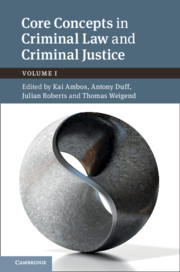Book contents
- Core Concepts in Criminal Law and Criminal Justice
- Core Concepts in Criminal Law and Criminal Justice
- Copyright page
- Contents
- Preface
- Abbreviations
- Contributors
- Part I Introduction
- Part II Criminal Law
- Part III Criminal Justice and Procedure
- 7 Proportionality of Punishment in Common Law Jurisdictions and in Germany
- 8 Criminal History Enhancements at Sentencing
- 9 Due Process
- 10 The Role of the Prosecutor
- 11 Negotiated Case Dispositions in Germany, England and the United States
- 12 Exclusion or Non-Use of Illegally Gathered Evidence in the Criminal Process: Focus on Common Law and German Approaches
- Index
- References
7 - Proportionality of Punishment in Common Law Jurisdictions and in Germany
from Part III - Criminal Justice and Procedure
Published online by Cambridge University Press: 19 December 2019
- Core Concepts in Criminal Law and Criminal Justice
- Core Concepts in Criminal Law and Criminal Justice
- Copyright page
- Contents
- Preface
- Abbreviations
- Contributors
- Part I Introduction
- Part II Criminal Law
- Part III Criminal Justice and Procedure
- 7 Proportionality of Punishment in Common Law Jurisdictions and in Germany
- 8 Criminal History Enhancements at Sentencing
- 9 Due Process
- 10 The Role of the Prosecutor
- 11 Negotiated Case Dispositions in Germany, England and the United States
- 12 Exclusion or Non-Use of Illegally Gathered Evidence in the Criminal Process: Focus on Common Law and German Approaches
- Index
- References
Summary
One of the most broadly accepted principles of punishment is that the severity of criminal sanctions should be proportional to the seriousness of the offence being punished. But proportionality requires a normative frame of reference – proportional relative to what underlying legal or normative values? Retributivists believe that punishment should be proportional to the offender’s degree of blameworthiness for the act(s) being punished. There are also several consequentialist (utilitarian) principles, which assess the proportionality of a penal measure relative to the expected benefits to be achieved by applying that measure. This chapter examines each of these meanings of proportionality in punishment, identifying the key elements of each concept, their similarities and differences, the ways in which common law legal systems and the German system have applied them and the possibilities for accommodating all of these principles in a single punishment model.
- Type
- Chapter
- Information
- Core Concepts in Criminal Law and Criminal Justice , pp. 213 - 260Publisher: Cambridge University PressPrint publication year: 2020
References
- 1
- Cited by



